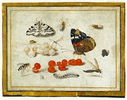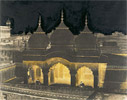
These lessons address the science of art production, conservation, and scholarship using the Getty's artworks and conservation practices.
The print version of this curriculum includes 36 lessons total. Eleven lessons from the print curriculum have been selected to be included in this online presentation.
To purchase a copy of Art & Science: A Curriculum for K–12 Teachers, visit The Getty Store.
|
 |
|
 |
 |
Lessons 1-9 of 11 |
 |
 |
 |
 |
 |

  |
 |
Insect Anatomy and the Scientist as Illustrator (Beginning Level)
Grades/Level: Lower Elementary (K–2), Upper Elementary (3–5)
Subjects: Visual Arts, Science
Lesson Overview: Students observe live insects and examine insects depicted in a seventeenth-century drawing. They identify the three characteristics of an adult insect: a three-part body (head, thorax, and abdomen), six legs, and antennae. They collect and draw live insects, incorporating a variety of shapes and lines.
|
 |
 |
 |
Insect Anatomy and the Scientist as Illustrator (Intermediate Level)
Grades/Level: Middle School (6–8)
Subjects: Visual Arts, Science
Lesson Overview: Students observe and study insects depicted in a seventeenth-century drawing. They identify characteristics common to all insects and those unique to particular species. Students research and draw insects, incorporating a variety of lines and shapes and using value to depict three-dimensionality.
|
 |
 |
 |
Insect Anatomy and the Scientist as Illustrator (Advanced Level)
Grades/Level: High School (9–12)
Subjects: Visual Arts, Science
Lesson Overview: Students study insects depicted in a seventeenth-century
drawing. They research winged insects, identifying unique characteristics and those common to all insects. Students closely observe winged insects and create detailed drawings of wings.
|
 |
 |
 |
Capturing Light: The Science of Photography (Beginning Level)
Grades/Level: Upper Elementary (3–5)
Subjects: Visual Arts, Science
Lesson Overview: Students create pinhole cameras to understand that light travels in a straight path. They describe the lines and shapes in a nineteenth-century photograph of a building and then use their pinhole cameras to trace the architecture of their school building.
|
 |
 |
 |
Capturing Light: The Science of Photography (Intermediate Level)
Grades/Level: Middle School (6–8)
Subjects: Visual Arts, Science
Lesson Overview: Students create pinhole cameras to learn how artists manipulate light to make photographs. They describe and analyze a nineteenth-century photograph and use their cameras to capture the architecture of their school or other buildings.
|
 |
 |
 |
Capturing Light: The Science of Photography (Advanced Level)
Grades/Level: High School (9–12)
Subjects: Visual Arts, Science
Lesson Overview: Students create and use pinhole cameras to understand how artists use and manipulate light to capture images in photographs. They shoot and develop photographs made with pinhole cameras. They compare and contrast a nineteenth-century image, photographs taken with a pinhole camera, and pictures created with a digital camera or camera phone.
|
 |
 |
 |
Fighting Corrosion to Save an Ancient Greek Bronze (Beginning Level)
Grades/Level: Upper Elementary (3–5)
Subjects: Visual Arts, Science
Lesson Overview: Students study an object from antiquity that was found
in the sea off the coast of Italy in order to understand how conservators remove and prevent corrosion on bronze statues. They derive meaning from analyzing the pose of the statue. Based on what they observe in the sculpture and what they read about the statue, students speculate about how the sculpture was lost at sea.
|
 |
 |
 |
Fighting Corrosion to Save an Ancient Greek Bronze (Intermediate Level)
Grades/Level: Middle School (6–8)
Subjects: Visual Arts, Science
Lesson Overview: Students study an ancient bronze statue, analyze its pose, and discover how conservators remove and prevent corrosion. They learn that the bronze used to make this sculpture is an alloy of copper and tin with small amounts of other elements. They use the periodic table to research the chemical formulas of compounds used to make bronze. Students compare conservation techniques in two ancient bronze objects.
|
 |
 |
 |
Fighting Corrosion to Save an Ancient Greek Bronze (Advanced Level)
Grades/Level: High School (9–12)
Subjects: Visual Arts, Science
Lesson Overview: Students study an ancient bronze statue, analyze its pose, and discover how conservators remove and prevent corrosion. They learn that the bronze used to make this sculpture is an alloy of copper and tin with small amounts of antimony, lead, iron, silver, nickel, and cobalt. They use the periodic table to research the chemical formulas of compounds used to make bronze. After learning about oxidation-reduction reactions that occurred in the statue, students speculate about the conservation techniques needed to conserve the bronze sculpture.
|
 |
 |
 |
 |
 |
 |
Lessons 1-9 of 11 |
 |
 |
 |
 |
 |

  |
 |








